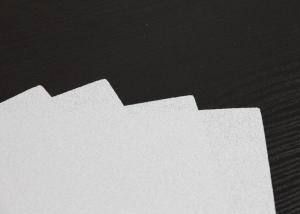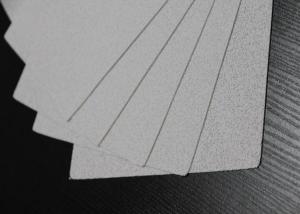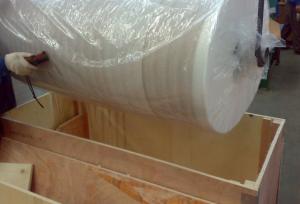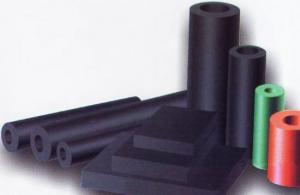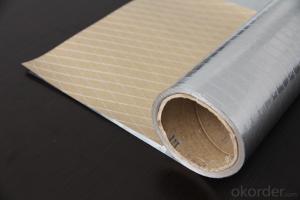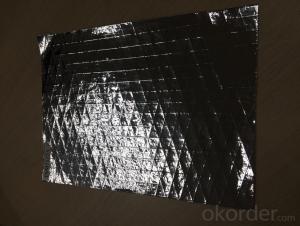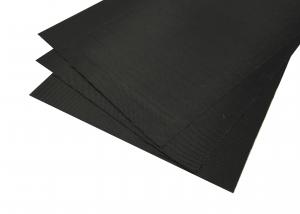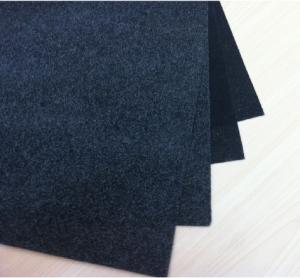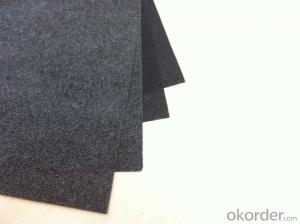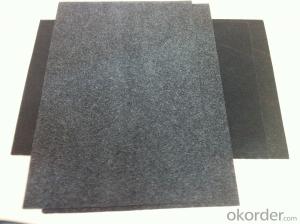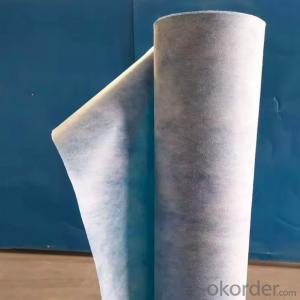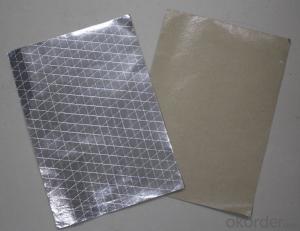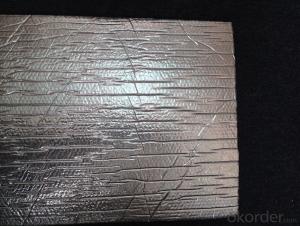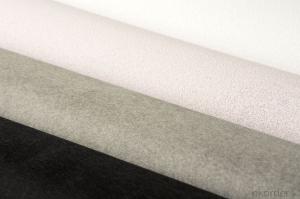White Spray Coating Tissue, 700#-W
- Loading Port:
- China Main Port
- Payment Terms:
- TT or L/C
- Min Order Qty:
- 10000M2 m²
- Supply Capability:
- 30000M2 Per Week m²/month
OKorder Service Pledge
OKorder Financial Service
You Might Also Like
Specifications of Spray Coating Tissue
700W
|
Specification | ||
|
ITEM |
UNIT |
VALUE |
|
Weight |
g/m2 |
380 |
|
Thickness |
mm |
0.55 |
|
Property ofFire Retardant |
|
Non-ignitability A level |
|
Tensile Strength MD |
n/5cm |
150 |
|
Tensile Strength CMD |
n/5cm |
110 |
SIZE:
Width: 0.6m---1.3m
Length: 50m-300m
Core I.D.: 3"(76mm ±1)
Based on order, special sizes are also available.
MSDS:No harm for body and environment, non-volatile product.
Remarks:
1. The data above are typical results and subject to change without notice.
2. Tolerance: Weight and Thickness: ±10%; Width: ±3mm; Length: ±0.5%.
3. The products should be stored at room temperature, kept from wet and kept away heat source.
4. Good appearance without stain, oxidation, mildew.
5. The users should take test and do trial-application on the above products before coming into application so as to witness and ensure suitability for their special purpose and technique.
Usage/Applications of Spraying Coating Tissue
Fiberglass facing is good at fireproof, mildew resistant, damp proof and strong air permeability. After laminated with glass wool or rock wool, the physical properties is excellent such as heat preservation, noise elimination, fire retardant, extinction, etc.
Packaging & Delivery of Spraying Coating Tissue
Each roll is packed by water-proof film

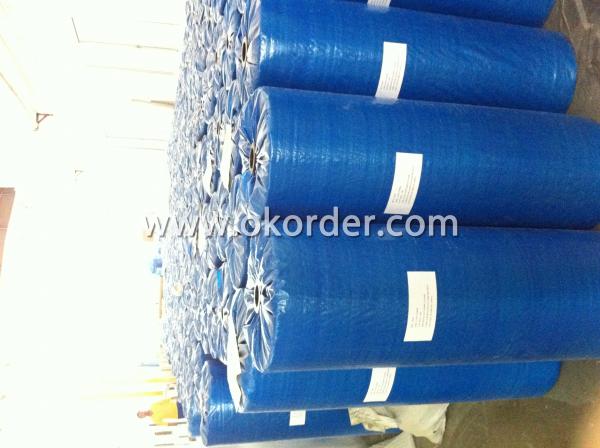
- Q:How does fiberglass facing improve insulation?
- By adding a layer of fiberglass facing, the insulation material is improved as it receives an extra layer of protection. This facing acts as a barrier, preventing the entry or escape of air and moisture from the insulation. This not only helps maintain the desired temperature inside the insulated area but also prevents the growth of mold or mildew. Moreover, the facing strengthens and increases the durability of the insulation, making it more resilient against damage and ensuring its longevity. Additionally, it enhances the fire resistance of the insulation, providing an additional level of safety. Overall, the fiberglass facing enhances the insulation's thermal performance, resistance to moisture, durability, and safety.
- Q:What is the typical thickness of fiberglass facing?
- The typical thickness of fiberglass facing can vary depending on the specific application and requirements. In general, fiberglass facing is available in thicknesses ranging from 0.5 millimeters to 2 millimeters. Thinner fiberglass facing, around 0.5 to 1 millimeter, is commonly used for lightweight and flexible applications such as insulation and acoustic panels. Thicker fiberglass facing, around 1.5 to 2 millimeters, is often used for more heavy-duty applications where higher strength and durability are required, such as in construction and industrial settings. It is important to consider the specific needs and specifications of a project to determine the appropriate thickness of fiberglass facing to ensure optimal performance and functionality.
- Q:Can fiberglass facing be used in both residential and commercial buildings?
- Yes, fiberglass facing can be used in both residential and commercial buildings. Fiberglass facing is a versatile material that offers several benefits such as thermal insulation, moisture resistance, and soundproofing. These qualities make it suitable for various applications in both residential and commercial settings. In residential buildings, fiberglass facing can be used in insulation products for walls, ceilings, and attics, helping to improve energy efficiency and reduce heating and cooling costs. It can also be used in residential HVAC systems to improve air quality and reduce noise transmission. In commercial buildings, fiberglass facing can be used in insulation products for walls, roofs, and HVAC ductwork, providing similar benefits as in residential settings. Additionally, fiberglass facing can be used in commercial acoustic panels and soundproofing systems to reduce noise levels in offices, conference rooms, and other commercial spaces. Overall, fiberglass facing is a versatile material that can be effectively used in both residential and commercial buildings to enhance insulation, moisture resistance, and soundproofing properties.
- Q:How is fiberglass facing installed?
- Fiberglass facing is typically installed by positioning it against the desired surface and securing it with adhesive or mechanical fasteners such as staples or screws. The facing is then smoothed out to remove any wrinkles or air bubbles, ensuring a tight and even installation.
- Q:Fiberglass Felt Polyester Powder Adhesive Details
- The chopped strand mats cut the glass precursor (sometimes with roving) into a 50 mm long, randomized but evenly laid out on a mesh belt, followed by an emulsion binder or a powdery powder. Bonding to chopped stranded mats. The chopped mat is mainly used for hand lay-up, continuous plate making and mold pressing and SMC processes.
- Q:Roof waterproof general use of what materials
- 1. EPDM rubber waterproofing membrane: cold sticky or self-adhesive method. 2. Chlorinated polyethylene waterproofing membrane: cold sticky method. 3. PVC waterproofing membrane: cold sticky method. 4. Chlorinated polyethylene - rubber blend waterproofing membrane: cold sticky method. 5. EPDM - polyethylene blend waterproofing membrane: cold sticky method. 6. Polyurethane waterproof coating: reactive cold construction. 7. Acrylic waterproof coating: cold construction, can be scraping, can be, can be sprayed, but the construction temperature needs to be higher than 4 ℃ when the film.
- Q:Can fiberglass facing be used in high-temperature applications?
- No, fiberglass facing cannot be used in high-temperature applications. Fiberglass is a type of reinforced plastic material that is known for its excellent thermal insulation properties and resistance to corrosion. However, it has a low melting point and is not suitable for use in high-temperature environments. When exposed to high temperatures, fiberglass can melt, warp, or degrade, compromising its structural integrity and insulation properties. Therefore, it is important to choose alternative materials specifically designed for high-temperature applications, such as ceramic fiber or metal facing, to ensure safety and optimal performance.
- Q:Does fiberglass facing help with soundproofing?
- Yes, fiberglass facing can help with soundproofing. Fiberglass is known for its excellent sound-absorbing capabilities, as it can effectively trap and dampen sound waves. When used as a facing material, fiberglass can enhance the soundproofing properties of a wall or ceiling by reducing noise transmission through it. The facing acts as a barrier that prevents sound from passing through, making it an effective solution for reducing noise pollution in various settings, such as homes, offices, studios, or even industrial environments. Additionally, fiberglass is lightweight, easy to install, and can be easily combined with other soundproofing materials for even better results.
- Q:Are there any health concerns associated with fiberglass facing?
- Yes, there are some health concerns associated with fiberglass facing. Fiberglass is made of tiny fibers that can become airborne and if inhaled, they can irritate the respiratory system. Prolonged exposure to fiberglass can lead to respiratory issues, such as coughing, wheezing, and even a condition called fiberglass lung. It is important to take proper precautions, such as wearing protective gear and working in well-ventilated areas, when handling fiberglass to minimize the health risks.
- Q:What are the potential drawbacks of using fiberglass facing?
- One potential drawback of using fiberglass facing is its susceptibility to damage and breakage. Unlike other materials like metal or concrete, fiberglass can be easily cracked or shattered if not handled with care. Another drawback is that fiberglass facing is not as strong or durable as some alternative materials, which could limit its use in certain applications that require higher strength or resistance to extreme conditions. Additionally, fiberglass can be more expensive compared to other materials, which may impact the overall cost of a project.
1. Manufacturer Overview |
|
|---|---|
| Location | Jangsu, China |
| Year Established | 1999 |
| Annual Output Value | Above US$0.3 billion |
| Main Markets | 0.00% Mid East 15.00% Northern Europe 15.00% North America 10.00% Eastern Asia 20.00% Africa 0.00% Eastern Europe 20.00% Southeast Asia 0.00% Oceania 0.00% Western Europe 0.00% Southern Europe 0South east asia;North America |
| Company Certifications | ISO 9001:2008 |
2. Manufacturer Certificates |
|
|---|---|
| a) Certification Name | |
| Range | |
| Reference | |
| Validity Period | |
3. Manufacturer Capability |
|
|---|---|
| a)Trade Capacity | |
| Nearest Port | Shanghai |
| Export Percentage | 41% - 50% |
| No.of Employees in Trade Department | 20 People |
| Language Spoken: | English; Chinese |
| b)Factory Information | |
| Factory Size: | Above 100,000 square meters |
| No. of Production Lines | Above 4 |
| Contract Manufacturing | OEM Service Offered; Design Service Offered |
| Product Price Range | Average |
Send your message to us
White Spray Coating Tissue, 700#-W
- Loading Port:
- China Main Port
- Payment Terms:
- TT or L/C
- Min Order Qty:
- 10000M2 m²
- Supply Capability:
- 30000M2 Per Week m²/month
OKorder Service Pledge
OKorder Financial Service
Similar products
New products
Hot products
Hot Searches
Related keywords
